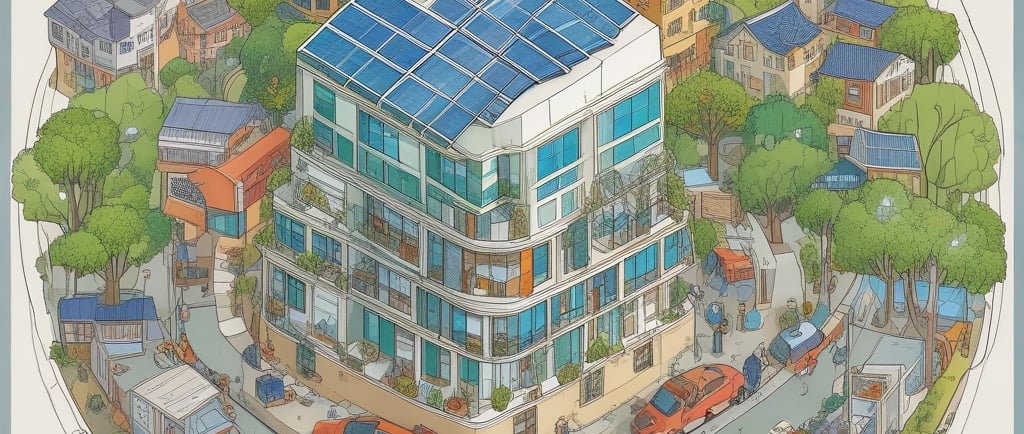Case Study Proposal: Net Zero Neighborhoods Powered by Autonomous Energy Commons
BAIoT.org proposes Autonomous Energy Commons—community-driven, decentralized energy ecosystems using Blockchain, AI, and IoT to enable real-time clean energy generation, trading, and carbon tracking, empowering neighborhoods to actively achieve net zero through inclusive, transparent, and intelligent climate action.
10/4/20254 min read


Case Study Proposal: Net Zero Neighborhoods Powered by Autonomous Energy Commons
Reimagining Urban Decarbonization with Blockchain, AI, and IoT
Presented by BAIoT.org
Executive Summary
The race to net zero is accelerating, but most climate strategies remain top-down, centralized, and slow to adapt. Cities, which account for over 70% of global emissions, are often treated as passive recipients of national policy rather than active agents of change. Meanwhile, local communities lack the tools to measure, manage, and monetize their own decarbonization efforts.
This case study proposal introduces a disruptive initiative by BAIoT.org to pilot Autonomous Energy Commons — decentralized, community-driven energy ecosystems that enable neighborhoods to generate, share, and trade clean energy while tracking and offsetting emissions in real time. By integrating Blockchain, Artificial Intelligence (AI), and the Internet of Things (IoT), this model empowers citizens to become active participants in the net zero transition, transforming passive homes into intelligent climate assets.
1. The Challenge: Net Zero Needs a Bottom-Up Revolution
Despite growing commitments to net zero, current approaches face critical limitations:
Centralized grids are slow to integrate renewables and vulnerable to outages.
Carbon accounting is retrospective, fragmented, and often unverifiable.
Energy poverty persists in urban areas, especially among low-income households.
Community engagement is minimal, with little incentive for local action.
Infrastructure inertia makes it difficult to retrofit existing buildings and systems.
To meet net zero goals, we need a new paradigm — one that decentralizes energy, democratizes data, and rewards participation.
2. The BAIoT.org Solution: Autonomous Energy Commons
BAIoT.org proposes a pilot project in partnership with a progressive city and a coalition of local stakeholders to deploy Autonomous Energy Commons in a mixed-income urban neighborhood. The initiative will create a decentralized energy ecosystem where homes, businesses, and public buildings:
Generate clean energy through solar, wind, and microgrids.
Share and trade energy using smart contracts and dynamic pricing.
Track emissions in real time with IoT sensors and AI analytics.
Offset carbon through verified local actions and tokenized credits.
2.1 IoT for Real-Time Energy and Emissions Monitoring
Smart meters track electricity generation, consumption, and grid interaction.
Environmental sensors measure indoor and outdoor air quality, temperature, and carbon intensity.
Appliance-level monitoring identifies energy efficiency opportunities.
Edge computing ensures privacy and low-latency decision-making.
IoT devices provide granular, real-time data that powers autonomous energy management.
2.2 AI for Optimization and Forecasting
Energy optimization algorithms balance supply and demand across the neighborhood.
Carbon attribution models calculate emissions based on energy source and usage patterns.
Predictive analytics forecast energy needs and renewable output.
Behavioral nudges encourage low-carbon choices through personalized feedback.
AI transforms raw data into actionable insights and automated decisions.
2.3 Blockchain for Trust, Trading, and Incentives
Smart contracts enable peer-to-peer energy trading and automated billing.
Tokenized carbon credits reward verified emissions reductions and offsets.
Decentralized registries store immutable records of energy flows and climate actions.
Community governance protocols allow residents to vote on energy policies and reinvestment.
Blockchain ensures transparency, accountability, and equitable participation.
3. Expected Outcomes
This pilot aims to demonstrate how Autonomous Energy Commons can accelerate the net zero transition at the neighborhood level.
3.1 Environmental Impact
Increased adoption of renewable energy and energy efficiency.
Real-time emissions tracking and verified reductions.
Local carbon offset generation and retirement.
3.2 Economic Empowerment
Lower energy costs through shared generation and optimized usage.
New income streams from energy trading and carbon credits.
Reduced energy poverty through inclusive access and subsidies.
3.3 Community Engagement
Active participation in climate governance and decision-making.
Strengthened social cohesion through shared infrastructure and goals.
Increased climate literacy and behavioral change.
3.4 Systemic Innovation
Shift from centralized utilities to decentralized commons.
Integration of energy, carbon, and social data into one platform.
Scalable model for cities, cooperatives, and housing developments.
4. Strategic Alignment with BAIoT.org’s Mission
This initiative reflects BAIoT.org’s commitment to ethical, inclusive, and impactful technology convergence:
Ethical: Data ownership remains with residents; privacy and consent are prioritized.
Inclusive: Designed for diverse communities, including low-income and marginalized groups.
Impactful: Directly contributes to net zero goals through measurable actions.
Collaborative: Co-created with local governments, technologists, and citizens.
5. Implementation Roadmap
Phase 1: Stakeholder Engagement and Planning
Partner with a city government, housing authority, and local energy providers.
Conduct participatory workshops to define goals, needs, and governance models.
Map existing infrastructure, energy usage, and community demographics.
Phase 2: Infrastructure Deployment
Install solar panels, microgrids, and battery storage across pilot buildings.
Deploy IoT sensors and smart meters for energy and emissions tracking.
Develop AI models for optimization and forecasting.
Set up blockchain infrastructure and community governance protocols.
Phase 3: Activation and Trading
Launch peer-to-peer energy trading via smart contracts.
Issue tokenized carbon credits for verified reductions and offsets.
Enable residents to manage energy, emissions, and earnings via mobile dashboards.
Phase 4: Monitoring and Evaluation
Track key metrics: energy savings, emissions reductions, participation rates.
Conduct independent audits and publish open-source methodologies.
Refine models and expand to additional neighborhoods.
6. Risk Management and Mitigation
Technical Risks
Device failure or data gaps: Mitigated through redundancy and edge processing.
AI model bias: Addressed through diverse training data and community oversight.
Social Risks
Resistance to technology: Managed through education, training, and trust-building.
Digital divide: Mitigated through inclusive design and offline access options.
Operational Risks
Regulatory barriers: Navigated through early engagement and policy alignment.
Funding gaps: Addressed through blended finance, grants, and community investment.
7. Broader Impact and Replicability
This pilot is designed to be replicable across urban contexts. By using open-source tools, modular architecture, and participatory governance, Autonomous Energy Commons can be adapted for:
Public housing developments seeking energy independence.
Eco-villages and intentional communities focused on sustainability.
Post-disaster recovery zones rebuilding resilient infrastructure.
It also supports multiple Sustainable Development Goals (SDGs), including:
SDG 7: Affordable and Clean Energy
SDG 11: Sustainable Cities and Communities
SDG 13: Climate Action
8. Call to Action
Net zero is not just a policy target — it’s a community journey. Autonomous Energy Commons offer a new path: one where neighborhoods generate their own power, govern their own systems, and share in the benefits of climate action.
BAIoT.org invites cities, technologists, researchers, and funders to join us in building decentralized energy ecosystems that fight climate change from the ground up.
Ways to Get Involved
Partner with us to pilot Autonomous Energy Commons in your city.
Contribute to open-source development of energy trading and carbon tracking tools.
Sponsor community engagement and infrastructure deployment.
Join our global coalition for ethical climate innovation.
Visit BAIoT.org to learn more, access resources, and become part of this transformative movement.
Conclusion
This case study proposal presents a disruptive vision: a world where net zero is not imposed from above, but built from below — by empowered communities using intelligent, secure, and inclusive technologies. By combining Blockchain, AI, and IoT, we can create Autonomous Energy Commons that turn every neighborhood into a climate solution.
BAIoT.org is ready to lead this change. Are you ready to join us?
Advocate
Pioneering the convergence of blockchain, AI, and IoT.
Connect
Support
Copyright © 2025 BAIoT.org. All rights reserved.
